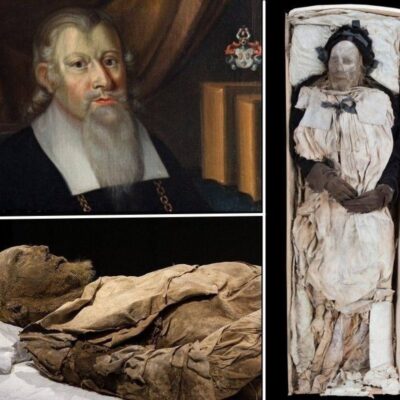A gray October day on Olkiluoto, an island far off the west coast of Finland. The car drove slowly to present itself through a heavily guarded security gate.

The road leading there was covered with crushed stone that made its tires squeak. But then the car suddenly disappeared, only the sound of tires was still echoing.
It sounds like a scene from a Marvel movie, but the car doesn’t really put on a stealth cover. It was just entering a tunnel that was camouflaged and hidden in the shadow of the forest.
Right at the top of that tunnel, there was a man waiting. “Welcome to Onkalo,” he said. Antti Mustonen is a geologist working here, Onkalo in Finnish means – “a hole” or “a hole”.
This tunnel was built to permanently bury spent fuel rods in nuclear reactors in Finland. In fact, we are witnessing the scene of a crypt for nuclear material, the world’s first permanent radioactive waste disposal site.

The car entered a tunnel hidden in the shadow of the forest in Olkiluoto. It’s going down to the world’s first permanent nuclear waste crypt.
The car that picked up Mustonen continued its journey deep below, through turns indicated by signal lights. It stopped at a large chamber where the walls were reinforced with shotcrete.
This is the crypt, which is still empty, but in a few years, the first expired fuel rods will be brought here to be buried. They will be encased in giant bronze crates, as tall as a giraffe.
The fuel rods will be dropped by a crane from above, and then will be received by an automatic robot. Human presence here is rare.
The robots will then drag the fuel rod into one of these catacombs. Below Onkalo, there are dozens of tunnels to destroy radioactive waste that are being built like an ant nest model.



Onkalo has dozens of tunnels to destroy radioactive waste that are being built like an anthill model.
In a tunnel under construction, Mustonen briefly explained about the noise of the exhaust fan, about the smell of rock dust still in the air and the smell of explosives still lingering. At his feet were mud and water—something not allowed in nuclear catacombs like these.
But Mustonen says that’s because construction isn’t complete yet, and the mud and water will then have to be cleaned up. Not only that, after the copper chests are buried, each of these bunkers will hold 30-40 boxes, they will be wrapped with bentonite, a type of clay that absorbs water.
Finally, concrete will be poured down to seal it all up. The catacombs will be sealed for at least 100,000 years, and everything will stay that way, undisturbed even if the climate warms or the next ice age hits the planet’s surface.
“Right here, in Finland’s most stable bedrock, 430 meters underground and 420 meters below sea level. That would be the ultimate disposal site,” Mustonen said.

Right here, in Finland’s most stable bedrock, 430 meters underground and 420 meters below sea level. That would be the final disposal site.
The problem with nuclear energy
Finland is currently a pioneer in the goal of reducing carbon emissions to zero, and it is lobbying other countries in the European Union (EU) to do the same. To set an example, this country is promoting zero-emission electricity production, in which nuclear energy is very focused.
Two of Finland’s four nuclear reactors are located on the island of Olkiluoto. By the end of this year, they will have one more plant connected to the national grid and increase the share of nuclear power to 40% of the country’s electricity production.
However, although nuclear power is zero-emissions, it has a major drawback in the uranium fuel rods after they expire. When uranium is fully mined and removed from the core of a nuclear reactor, it is still hot and highly radioactive.
Previously in Finland, the rods would have been kept in water tanks, where they would take decades to cool down and become radioactive. Some other countries dip fuel rods into thick concrete and steel “dry storage” tanks.
“But it’s not safe to do so – disaster is bound to happen in the future,” said Budhi Sagar, a nuclear expert at the Southwest Research Institute in the US. Aboveground storages are prone to accidents, leaks, or neglect. It is still dangerous to store nuclear waste there.
Sargar said that right now groundwater in Hanford, Washington state is being contaminated by former US Department of Energy (DOE) waste storage tanks that leak. These are the first US plutonium reactors for nuclear weapons production.

Expired fuel rods are “stored dry” in concrete and thick steel. But they still run the risk of leaking if left on the ground.
So the more we switch to clean energy, the more we need to use nuclear energy. And the more nuclear power is used, the more radioactive waste will pile up. If there is no permanent solution, they are time bombs to us.
In 2019, Finland’s nuclear reactors released a total of 2,300 tons of radioactive waste. The worldwide figure is 263,000 tons, according to estimates by the International Atomic Energy Agency (IAEA). All of this expired fuel is currently in temporary storage facilities around the world
Tom Isaacs, strategic advisor to the Nuclear Waste Management Organization of Canada (NWMO) and Southern California Edison, said: “In my view, it’s an unacceptable legacy, stuff. which we have bequeathed to future generations, having generated this current and reaping the full benefits from it”.
Build a crypt
The Onkalo nuclear crypt is a project operated by Posiva, a company specializing in the treatment of nuclear waste in Finland. They had the idea to build it in the early 1990s. At that time, experts in Posiva went to survey dozens of sites over the years, finally only to select the area on Olkiluoto island in 1999.
That’s because geological measurements show that the foundation under this area has been stable for at least the past 1 billion years. The last earthquakes in Olkiluoto occurred during the Pleistocene ice age 10,000 to 110,000 years ago. And geologists think the region won’t experience any more earthquakes until the next ice age.

The foundation beneath Onkalo has been stable for at least the past 1 billion years. Geologists say the area won’t experience any more earthquakes until the next ice age.
Mustonen said that Onkalo has a favorable location, because it is located right between two parallel fault zones about 800 meters apart. If an earthquake occurs, it will occur along those existing fault lines. “They will absorb the shocks and nothing will happen here, in the middle,” he said.
But earthquakes are not the biggest and only threat to the radioactive catacombs in Onkalo. Sarah Hirschorn, director of geosciences at NWMO, said it was the water they were most worried about.
“The only way for radiation to leak out of this vault and affect people is through water,” he said. And that’s why they chose to build Onkalo on a site that has both crystalline rock, clay, and salt.

The bedrock is nearly 2 billion years old, mainly gneiss, a hard rock tempered by high temperature and pressure. They have small but unconnected pores and are virtually impermeable to water.
However, there is still one factor to take into account: the rocks can have cracks. Posiva surveyed and mapped these cracks to avoid drilling into them. Neil Chapman, a geologist who served as an independent consultant for the Finnish Nuclear and Radiation Safety Authority (STUK) said:
“It is these cracks that control the movement of water. If they discover any significant cracks near a radioactive waste storage pit, that pit will be immediately sealed off, unused arrive”.

Posiva surveyed and mapped the cracks to avoid drilling into them. If they discover any significant cracks near a radioactive waste storage pit, the pit will be immediately sealed off and unused.
The next scenario that happens is that somehow, water can still seep into the storage. For now, it will still have to pass two more layers of protection, of bentonite and copper, to reach the radioactive fuel rod.
It’s like you can’t put all your eggs in one basket, says Emily Stein, a deep geoprocessing researcher at Sandia National Laboratory. It should always be taken into account that “one defense mechanism will fail, then you still have other barriers to being able to minimize or prevent radioactive waste from leaking”.
Buried forever
Talk about discarded nuclear fuel rods. Once brought to Onkalo, they will be wrapped in a packing factory built directly above the catacombs. In a stainless steel room clad in concrete walls 1.3 meters thick, only robots will be tasked with sucking up the remaining water in the fuel.
The robots then seal them in a cast iron box, nesting the inside of a copper tube. Argon will be injected between the two layers of material to create an inert atmosphere and finally another layer of copper barrel is welded on the outside.

Wasted nuclear fuel rods are coated with copper before being buried underground.


Copper is chosen because this metal corrodes very slowly. Scientists at Onkalo calculate that, by the time the first drop of groundwater seeps down from the ground to the depths of the bunkers here, chemical reactions or microorganisms along the way will be consumed. depleted oxygen dissolved in the water, making the water inert and less reactive.
But Peter Szakálos, a chemist at the KTH Royal Institute of Technology in Stockholm, still has concerns. In a 2007 study, he and his colleagues discovered signs that copper can corrode even in pure, oxygen-free water.
When the metal came into contact with water, Szakálos and his colleagues noticed that it released a jet of hydrogen gas. He suspects water could still react with copper to form an oxide crystal with free hydrogen being released or absorbed into the metal itself.
When hydrogen is absorbed, it makes copper brittle and prone to cracking, says Szakálos. And given the depth of Onkalo and the thickness of the copper they’re using, he predicts radiation could leak out as the copper is destroyed in the space of a few decades to a few centuries. “It’s all just a matter of time,” Szakálos said.
However, for their part, Posiva and one of their partners, SKB, a Swedish nuclear waste management company, do not believe in that scenario. They assert that the experimental conditions of Szakálos do not match the geology of Onkalo.
Even so, SKB has contracted with Uppsala University and the University of Toronto to try to replicate the findings and risks Szakálos warned about. Subsequent tests by Uppsala University did not find any evidence of copper reacting in pure water. While the team at the University of Toronto did observe a response, it was also extremely slow.


Beneath a burial pit of copper boxes in Onkalo, they are also stuffed with a layer of waterproof bentonite clay.
In addition, on the outside of the copper tanks that cover the fuel rods, there is another layer of bentonite. They will prevent water and even the leakage of radioactive waste. Bentonite is a mineral clay that is not only waterproof but also prevents bacteria from entering the copper pipe surface.
Karsten Pedersen, CEO of Microiotics Analytics, a Swedish company that studies the effects of bacteria on deep storage tanks, says bacteria can metabolize sulfates in groundwater and turn them into sulfide, a substance can corrode copper slowly.
Posiva acknowledges that possibility, but the company’s calculations show that even in high sulfide concentrations, its copper boxes will still have a lifespan of more than 100,000 years. And even if all the defenses at Onkalo fall, the radiation in the fuel rods here still faces one final obstacle: depth.
They will take decades to reach the surface, with radioactive concentrations decreasing continuously with the height of the geological layer. The Onkalo project’s overall assessments have drawn up the worst possible scenarios, and even then, the impact of radioactive leaks is minimal.
For those who lived near the site and drank contaminated water from a dug well, their annual exposure was still comparable to the radiation a person in Finland today is exposed to.


Onkalo is being rushed to complete to welcome the first “retired” nuclear fuel rods in 2024.
Scenarios, calculations and numbers are on the side of Posiva and their project team at Onkalo. In December last year, they obtained a permit from the Finnish government to officially open their radioactive waste burial site in 2024.
After that, the process of building new bunkers will be carried out in parallel with the process of gathering and transporting nuclear waste here. It is expected that all of Onkalo’s warehouses will be filled by 2120.
At that time, Posivia will pour a thick layer of concrete to close this crypt area permanently. All auxiliary factory systems and architecture above Onkalo will be demolished. The site of the area will be returned to its original state, without even a warning or instruction sign being placed there.
But deep underground, the 6,500 tons of radioactive waste resting in their catacombs still smolder day and night to slowly decay.
Onkalo is a work that demonstrates our generation’s responsibility to future generations, Mustonen said. “Only a sense of responsibility to future generations can keep me up all night to work here. All because of the two words responsibility.”











